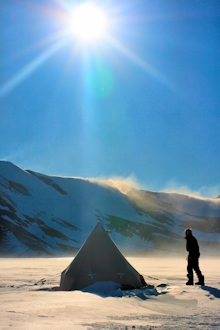West Antarctica's ice sheet
Posted on 11 May 2012

An international team of researchers has warned that the stability of a part of the West Antarctic Ice Sheet is potentially under threat following a survey of the Institute and Möller ice streams.
The team, which included Dr David Rippin, from the University of York’s Environment Department, surveyed the thickness of the ice streams which feed the Filchner-Ronne Ice Shelf to determine the underlying landscape.
Details of the research, which received support from the UK Natural Environment Research Council, are published in Nature Geoscience this week.
The research, which was led by the University of Edinburgh, involved carrying out an airborne geographical survey across a previously poorly understood region of West Antarctica – the Weddell Sea Embayment.
Until now, attention has been focussed on ice-sheet changes in the Siple Coast and the Amundsen Sea embayment sectors of West Antarctica. Little attention has previously been given to this third sector. However, the team’s work revealed a steep reverse slope and a large subglacial basin here (around the size of Wales) upstream of where the West Antarctic Ice Sheet meets the Weddell Sea. This is significant because such a reverse slope facilitates accelerating ice-sheet decay as the grounding line retreats across a deepening bed.
Dr Rippin played a significant role in processing and analysing the data. He said: “The reverse slope here is particularly steep and our measurements showed that the bed is fairly smooth, with little in the way of ‘pinning points’ that could delay retreat of the ice sheet. Taken together with projected increasing melt rates, this raises concerns about the future of the Weddell Sea Sector of the West Antarctic Ice Sheet.”
The article “Steep reverse bed slope at the grounding line of the Weddell Sea sector in West Antarctica” is published in Nature Geoscience at http://dx.doi.org/10.1038/ngeo1468
The study involved researchers from the Environment Department, University of York; School of GeoSciences, University of Edinburgh; School of Geosciences, University of Aberdeen; British Antarctic Survey, Cambridge; Geography, College of Life and Environmental Sciences, University of Exeter; Institute of Geophysics, University of Texas, USA.

